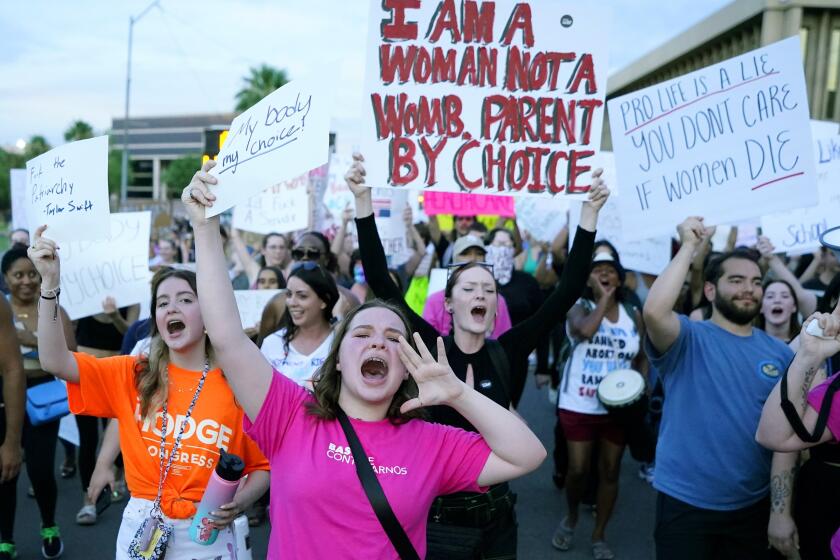White supremacists and Islamic State recruits have more in common than you might think

On the surface, white supremacists and Islamic State recruits would not seem to have much in common. One group embraces a racist, anti-immigrant ideology and is mobilized by fear that a majority of people in the United States will soon no longer be white. The other group believes it must kill “infidels” and create an Islamic “caliphate.”
Terrorism experts, however, say the radicalization process, tactics and narratives used by violent white nationalists are actually strikingly similar to those employed by Islamic State. Understanding what the two groups have in common, experts say, can help officials develop a strategy for preventing homegrown extremism.
“I see extremism as a structure for beliefs,” said J.M. Berger, author of the book “Extremism.” “We need to do a better job in treating extremism as a universal phenomenon.”
The challenge of combating domestic terrorism and white supremacist violence was thrust into the spotlight after a gunman, who is alleged to have posted a racist screed online, went on a bloody rampage Saturday, killing 22 people in the aisles and parking lot of a Walmart in El Paso. (Several hours later, another shooter, who had reportedly held leftist beliefs, killed nine people in Dayton, Ohio.)
Many were quick to point out how the Trump administration has shifted resources away from a Department of Homeland Security program meant to counter violent extremism, including far-right and white supremacist groups, to focus mainly on combating Islamist extremism. On Tuesday, Rep. Bennie Thompson (D-Miss.), ranking member of the Committee on Homeland Security, released an action plan to address the threat of domestic terrorism.
Despite their ideological differences, white supremacists and supporters of Islamic State derive their strength from a similar narrative: They believe they are in the midst of an existential crisis that threatens their way of life and that the only way to ensure self-preservation is to use violence, experts say.
“These groups have apocalyptic and exclusionist ideologies that are repeated and circulated in order to serve as a rallying point to susceptible individuals,” said Bruce Hoffman, a senior fellow at the Council on Foreign Relations.
Although there’s no magic formula to predict who will be drawn to extremist ideologies, experts have identified broad personality traits when it comes to Islamic State recruits and white nationalists: young men who feel alienated, marginalized or lack a sense of community.
The radicalization process doesn’t happen overnight. And just because a person might feel ostracized doesn’t mean they’ll necessarily succumb to using violence.
“The thinking that terrorists appear out of nowhere is misleading. It doesn’t occur in a vacuum,” Hoffman said.
One theory that describes how people end up carrying out terrorist attacks is called the staircase model. A Georgetown University psychology professor, Fathali Moghaddam, coined that term in a paper published in 2005.
According to Moghaddam, all members of society start out at the bottom floor and remain there if they feel content with their living conditions. If people feel discontent, they climb to the second level to try to find a solution. At that point, if an individual hits a dead end and continues to feel unsatisfied, he or she might begin to feel angry, frustrated and eager to point fingers at a target, such as a government or religious and ethnic groups. It’s at this stage that experts say intervention is necessary.
People who climb to the third floor begin to feel comfortable with the idea of using violence against their perceived threat. Individuals are also susceptible to recruitment at this stage. A person climbs to the fourth floor when he or she is recruited by an extremist group. At that point, Moghaddam says, there’s little that can be done to prevent the person from climbing to the fifth and final floor, which is when violence is used against the target.
There are obviously significant differences between white supremacists and Islamic State recruits. One is organizational: Islamic State has a leader members can rally around -- Abu Bakr Baghdadi -- and at one point established a government that administered large swaths of land in Iraq and Syria, albeit for a short time.
White supremacist groups, by contrast, are intentionally decentralized and fragmented.
Law enforcement’s infiltration into white supremacist groups in the 1970s and ’80s was the catalyst that spurred the movement’s leaders to adopt that model.
Since then, leaders of various white nationalist movements, such as Richard Spencer of the National Policy Institute, haven’t had much success in consolidating power when they’ve tried, said Scott Stewart, vice president of tactical analysis at the Texas-based global intelligence firm Stratfor.
For instance, the 2017 “Unite the Right” march in Charlottesville, Va., brought in an array of far-right groups, but the situation got out of hand when they were confronted by counter-demonstrators. The rally was canceled and violence ensued, culminating when a white supremacist drove into a crowd and killed a counter-protester.
However, Stewart said a decentralized strategy of relying on social media, online forums and private meetings has worked for white supremacist groups.
Three individuals with ties to racist or white supremacist ideology are alleged to have posted on the online forum 8chan prior to killing people: the suspect in the New Zealand mosque massacre of 49 people in March; the suspected gunman in the attack at a Poway synagogue in April; and the suspect in El Paso.
“Social media sites and forums like 8chan act as an echo chamber. People are feeding off the violence,” Stewart said.
Hoffman says he worries that the internet and social media sites have sped up the radicalization process. “The threats from these groups are evolving and moving much faster because of the power of social media in recent years,” he said.
Data show that far right groups have been carrying out deadlier attacks than in the past.
Since the Sept. 11, 2001, terrorist attacks, far-right groups have killed around the same number of Americans (109) as jihadist groups (107), according to data compiled by New America, a Washington-based think tank.
“It’s becoming increasingly clear that we may be witnessing a shift in tactics over the past couple of years,” David Sterman, a senior policy analyst at New America, said in reference to an increase in deadly attacks by white supremacists.
For years, counter-terrorism experts and government officials have been voicing concern over the increasing threat posed by individuals inspired by far-right and white supremacist groups; a Department of Homeland Security report warned elected officials about the increasing threat of domestic terrorism in 2009.
And FBI data show that hate crimes increased for the third consecutive year in 2017, up 17% from the year prior.
Red flags popped up again in May when Michael McGarrity, head of the FBI’s counter-terrorism unit, testified during a congressional hearing that of the roughly 850 domestic terrorism cases the bureau was investigating, 40% involved racially motivated violent extremism, and again last month when FBI Director Christopher A. Wray told the Senate Judiciary Committee that a majority of domestic terrorism cases the bureau has investigated are motivated by white supremacy.
In recent years, Islamic State has been following in the footsteps of white nationalist groups when it comes to using social media and online forums to disseminate information, chat with vulnerable individuals and inspire violence on such platforms.
As Islamic State’s caliphate has withered, the group has been relying less on its leaders to spread ideology and are focusing more on the power of social media to inspire individuals to carry out attacks on its behalf, Hoffman said.
Experts say the threat from Islamic State in this country comes mainly from individuals radicalized in the U.S., such as Joshua Cummings, who shot and killed a transit guard in 2017 in Denver, and Corey Johnson, a 17-year-old who converted to Islam and, after watching extremist videos, allegedly stabbed three people during a sleepover in Palm Beach Gardens, Fla., in 2018.
According to New America, 84% of people charged with Islamic State-related terrorism offenses are U.S. citizens or legal permanent residents, according to New America.
Islamic State “is replicating what white supremacists were the first ones to do, whether consciously or not,” Hoffman said.
More to Read
Sign up for Essential California
The most important California stories and recommendations in your inbox every morning.
You may occasionally receive promotional content from the Los Angeles Times.











